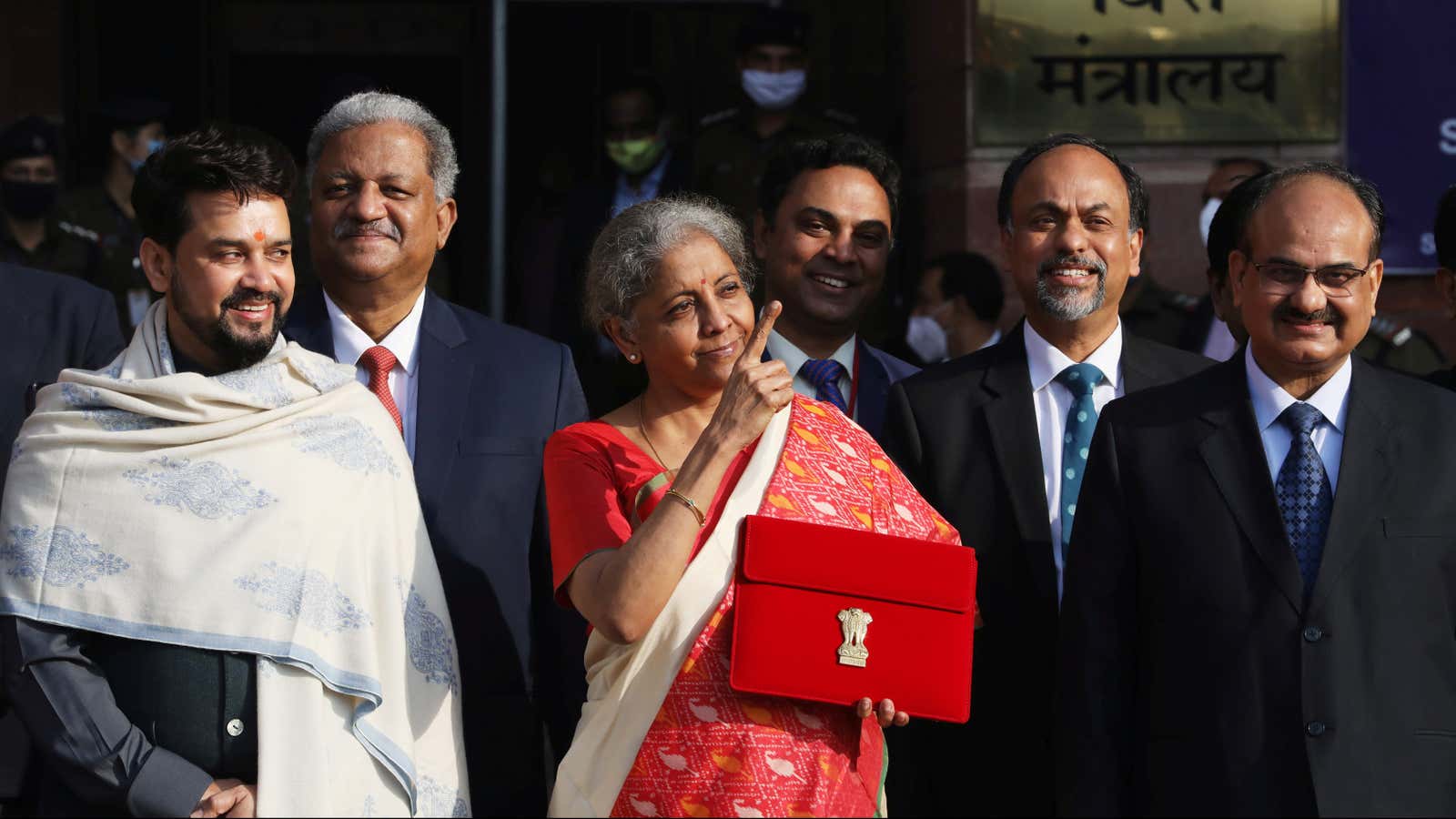This post has been corrected.
With the Covid-19 pandemic rampaging the global economy, governments across the world are trying to maintain a balance between spending to spur growth and holding back for long-term survival. India, it seems, has decided to go with the former.
In its ninth union budget, the Narendra Modi government today (Feb. 1) announced massive expenditure on areas such as infrastructure and healthcare in fiscal 2021-22 (April-March).
While spending in health-related areas is needed to fight the coronavirus pandemic, investments in infrastructure are aimed at creating more jobs to fight the historic unemployment problem. Job creation will also put more money in the hands of individuals, which would in turn spur the economy. The unemployment rate in India had climbed to 9% in December 2020.
This spending, however, will come at a cost as the government has decided to ignore fiscal prudence for the moment.
Funding economic growth
Indian finance minister Nirmala Sitharaman allocated Rs2.24 lakh crore ($30.67 billion) on the “health and wellbeing” section of her budget for FY22, which she said is 137% higher year-on-year.
This outlay, however, includes a vast spectrum of programmes that relate directly and indirectly—some by a stretch—to healthcare. For instance, the outlay will cover India’s Covid-19 vaccination plan, investments in creating healthcare-related infrastructure (hospitals, hospital blocks, public health labs, etc), nutrition programmes, and also clean water, sanitization and environment initiatives such as a voluntary vehicle scrapping policy.
Of the overall healthcare spending, the government has allocated Rs35,000 crore for Covid-19 vaccines.
There have been 10.07 million Covid-19 cases in India with 154,392 deaths. India has approved two vaccines so far—homegrown Covaxin of Bharat Biotech and Serum Institute of India’s (SII) Covishield made from the master seed of the Oxford-AstraZeneca vaccine. The government has bought vaccine doses to cover 30 million frontline staff and hopes to cover another 270 million by August this year. Outside the union budget, the Indian government had made an allocation of Rs480 crore for the vaccination drive in January 2021.
Besides the higher healthcare spending, in line with expectations, Sitharaman’s budget focused heavily on infrastructure, which is the need of the hour. The government has proposed a capital expenditure of Rs5.54 lakh crore, a 34% increase from Rs4.12 lakh crore budgeted in fiscal 2021.
This thrust on infrastructure comes after a cut in spending in the current financial year. In 2020, the Indian government as well as the private sector reduced their expenditure on building infrastructure. While the private sector was unwilling to invest in its expanding capacity due to weak demand and sales, the Indian government’s spending on infrastructure projects like roads and houses was restricted due to revenue shortfall.
The government will also set up a development finance institution called the National Bank for Financing Infrastructure and Development with a capital outlay of Rs20,000 crore. This institution, it hopes, will finance important national infrastructure projects at a low borrowing cost. The lending target for the institution would be Rs5 lakh crore over the next five years.
To fund these ambitious plans, the government is hoping to rely on a resource that it has time and again hoped would work but is yet to deliver.
Modi’s divestment plans
Like several previous years, the Modi government is hoping it will raise truckloads of money by divesting stakes in some of the companies it owns to fund its spending plans. The problem is that it has never succeeded at doing this and mostly missed its divestment targets.
Sitharaman said the government will be divesting a stake in its crown jewels 60-year-old insurer Life Insurance of India through an initial public offer, which will fetch it a fat cheque. Other major divestment candidates Sitharaman named, include beleaguered national carrier Air India, oil and gas firm Bharat Petroleum Corporation, Shipping Corporation of India, Container Corporation of India, and IDBI Bank.
Some of these names have been floating around for a few years now but haven’t found any takers.
Sitharaman has gone a step further this time as she said the government will be looking to privatise two state-owned banks, besides IDBI Bank, she said.
It will also set up an asset reconstruction and management company to tackle the issue of burgeoning bad loans, a much-needed measure to free up banks to lend more during the grim economic environment.
New fiscal target
Apart from raising funds through the divestment route, the Indian government would need to borrow to fill the giant fiscal deficit hole. With the total expenditure outweighing revenue, the fiscal deficit to GDP ratio is set to rise to 9.5% this year and will only come down marginally to 6.8% in the next financial year.
The Indian government will end up borrowing around Rs12 lakh crore in the financial year 2022, the finance minister said. This will lead to an increase in the cost of borrowing for corporates because as the price of government bonds, which are free of risk, goes up due to high borrowing, the market also raises the cost of capital for companies.
Correction: A previous version of this post incorrectly mentioned India’s Covid-19 death toll as 154,392 lakh. The correct figure is 154,392.
